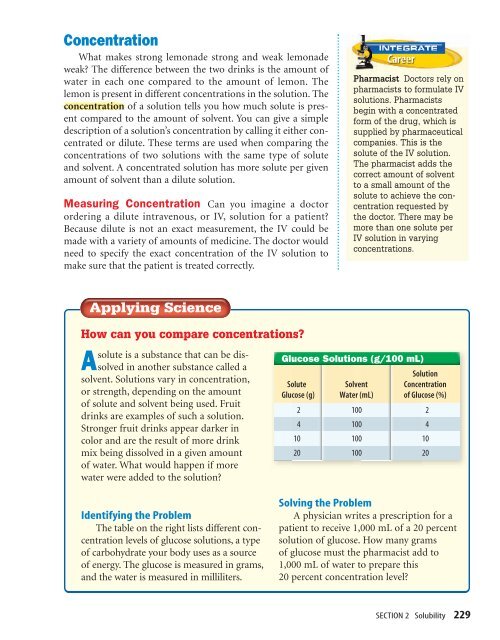Substances, Mixtures, and Solubility - McGraw-Hill Higher Education
Substances, Mixtures, and Solubility - McGraw-Hill Higher Education
Substances, Mixtures, and Solubility - McGraw-Hill Higher Education
Create successful ePaper yourself
Turn your PDF publications into a flip-book with our unique Google optimized e-Paper software.
Concentration<br />
What makes strong lemonade strong <strong>and</strong> weak lemonade<br />
weak The difference between the two drinks is the amount of<br />
water in each one compared to the amount of lemon. The<br />
lemon is present in different concentrations in the solution. The<br />
concentration of a solution tells you how much solute is present<br />
compared to the amount of solvent. You can give a simple<br />
description of a solution’s concentration by calling it either concentrated<br />
or dilute. These terms are used when comparing the<br />
concentrations of two solutions with the same type of solute<br />
<strong>and</strong> solvent. A concentrated solution has more solute per given<br />
amount of solvent than a dilute solution.<br />
Measuring Concentration Can you imagine a doctor<br />
ordering a dilute intravenous, or IV, solution for a patient<br />
Because dilute is not an exact measurement, the IV could be<br />
made with a variety of amounts of medicine. The doctor would<br />
need to specify the exact concentration of the IV solution to<br />
make sure that the patient is treated correctly.<br />
Pharmacist Doctors rely on<br />
pharmacists to formulate IV<br />
solutions. Pharmacists<br />
begin with a concentrated<br />
form of the drug, which is<br />
supplied by pharmaceutical<br />
companies. This is the<br />
solute of the IV solution.<br />
The pharmacist adds the<br />
correct amount of solvent<br />
to a small amount of the<br />
solute to achieve the concentration<br />
requested by<br />
the doctor. There may be<br />
more than one solute per<br />
IV solution in varying<br />
concentrations.<br />
How can you compare concentrations<br />
Asolute is a substance that can be dissolved<br />
in another substance called a<br />
solvent. Solutions vary in concentration,<br />
or strength, depending on the amount<br />
of solute <strong>and</strong> solvent being used. Fruit<br />
drinks are examples of such a solution.<br />
Stronger fruit drinks appear darker in<br />
color <strong>and</strong> are the result of more drink<br />
mix being dissolved in a given amount<br />
of water. What would happen if more<br />
water were added to the solution<br />
Glucose Solutions (g/100 mL)<br />
Solution<br />
Solute Solvent Concentration<br />
Glucose (g) Water (mL) of Glucose (%)<br />
2 100 2<br />
4 100 4<br />
10 100 10<br />
20 100 20<br />
Identifying the Problem<br />
The table on the right lists different concentration<br />
levels of glucose solutions, a type<br />
of carbohydrate your body uses as a source<br />
of energy. The glucose is measured in grams,<br />
<strong>and</strong> the water is measured in milliliters.<br />
Solving the Problem<br />
A physician writes a prescription for a<br />
patient to receive 1,000 mL of a 20 percent<br />
solution of glucose. How many grams<br />
of glucose must the pharmacist add to<br />
1,000 mL of water to prepare this<br />
20 percent concentration level<br />
SECTION 2 <strong>Solubility</strong> 229

















